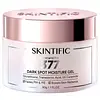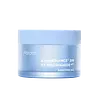What's inside
What's inside
 Key Ingredients
Key Ingredients

 Benefits
Benefits

 Concerns
Concerns

 Ingredients Side-by-side
Ingredients Side-by-side

Water
Skin ConditioningPropanediol
SolventNiacinamide
SmoothingCaprylyl Methicone
Skin ConditioningBifida Ferment Lysate
Skin ConditioningErythritol
HumectantGlycerin
HumectantCaprylic/Capric Triglyceride
MaskingTranexamic Acid
AstringentPanthenol
Skin ConditioningHydroxyethylpiperazine Ethane Sulfonic Acid
BufferingGlutathione
Limnanthes Alba Seed Oil
Skin ConditioningCentella Asiatica Extract
CleansingIsononyl Isononanoate
EmollientButylene Glycol
HumectantCetearyl Olivate
Ceramide NP
Skin ConditioningAmmonium Acryloyldimethyltaurate/Beheneth-25 Methacrylate Crosspolymer
Emulsion StabilisingDimethicone/Vinyl Dimethicone Crosspolymer
Skin ConditioningPotassium Cetyl Phosphate
EmulsifyingPentylene Glycol
Skin ConditioningHydroxyacetophenone
AntioxidantAcrylates/C10-30 Alkyl Acrylate Crosspolymer
Emulsion StabilisingSorbitan Olivate
EmulsifyingTromethamine
BufferingCeramide Ns
Skin ConditioningSodium Hyaluronate
HumectantInositol
HumectantCeramide AP
Skin ConditioningCeramide As
Skin ConditioningAesculus Chinensis Extract
AstringentCeramide EOP
Skin ConditioningPolymethylsilsesquioxane
Caprylyl Glycol
EmollientPEG/PPG-17/6 Copolymer
SolventNonapeptide-1
Skin ConditioningPhytosteryl/Octyldodecyl Lauroyl Glutamate
Skin ConditioningCyclodextrin
AbsorbentDimethicone
EmollientBis-PEG/PPG-20/5 PEG/PPG-20/5 Dimethicone
EmulsifyingMethoxy PEG/PPG-25/4 Dimethicone
EmulsifyingAdenosine
Skin ConditioningCholesterol
EmollientPhytosphingosine
Skin ConditioningHydrogenated Lecithin
EmulsifyingEthylhexylglycerin
Skin Conditioning1,2-Hexanediol
Skin ConditioningTocopherol
AntioxidantPhenylethyl Resorcinol
AntioxidantStearic Acid
CleansingCetearyl Alcohol
EmollientTocopheryl Acetate
AntioxidantSilica
AbrasiveDisodium EDTA
Xanthan Gum
EmulsifyingWater, Propanediol, Niacinamide, Caprylyl Methicone, Bifida Ferment Lysate, Erythritol, Glycerin, Caprylic/Capric Triglyceride, Tranexamic Acid, Panthenol, Hydroxyethylpiperazine Ethane Sulfonic Acid, Glutathione, Limnanthes Alba Seed Oil, Centella Asiatica Extract, Isononyl Isononanoate, Butylene Glycol, Cetearyl Olivate, Ceramide NP, Ammonium Acryloyldimethyltaurate/Beheneth-25 Methacrylate Crosspolymer, Dimethicone/Vinyl Dimethicone Crosspolymer, Potassium Cetyl Phosphate, Pentylene Glycol, Hydroxyacetophenone, Acrylates/C10-30 Alkyl Acrylate Crosspolymer, Sorbitan Olivate, Tromethamine, Ceramide Ns, Sodium Hyaluronate, Inositol, Ceramide AP, Ceramide As, Aesculus Chinensis Extract, Ceramide EOP, Polymethylsilsesquioxane, Caprylyl Glycol, PEG/PPG-17/6 Copolymer, Nonapeptide-1, Phytosteryl/Octyldodecyl Lauroyl Glutamate, Cyclodextrin, Dimethicone, Bis-PEG/PPG-20/5 PEG/PPG-20/5 Dimethicone, Methoxy PEG/PPG-25/4 Dimethicone, Adenosine, Cholesterol, Phytosphingosine, Hydrogenated Lecithin, Ethylhexylglycerin, 1,2-Hexanediol, Tocopherol, Phenylethyl Resorcinol, Stearic Acid, Cetearyl Alcohol, Tocopheryl Acetate, Silica, Disodium EDTA, Xanthan Gum
Water
Skin ConditioningNiacinamide
SmoothingCyclopentasiloxane
EmollientGlycerin
HumectantDimethicone
EmollientButylene Glycol
HumectantEthylhexyl Methoxycinnamate
UV AbsorberAmmonium Acryloyldimethyltaurate/Vp Copolymer
Phenoxyethanol
PreservativeButyl Methoxydibenzoylmethane
UV AbsorberPolysorbate 20
EmulsifyingCarbomer
Emulsion StabilisingDisodium EDTA
Allantoin
Skin ConditioningChlorphenesin
AntimicrobialSilica
AbrasiveTocopheryl Acetate
AntioxidantDimethicone/Vinyl Dimethicone Crosspolymer
Skin ConditioningPentylene Glycol
Skin ConditioningPotassium Hydroxide
BufferingParfum
MaskingAmodimethicone
Sodium Hydroxide
BufferingGlycyrrhiza Glabra Root Extract
BleachingActinidia Polygama Fruit Extract
Skin ConditioningTrideceth-9
EmulsifyingPEG-40 Hydrogenated Castor Oil
EmulsifyingEthylhexylglycerin
Skin ConditioningCI 42090
Cosmetic ColorantWater, Niacinamide, Cyclopentasiloxane, Glycerin, Dimethicone, Butylene Glycol, Ethylhexyl Methoxycinnamate, Ammonium Acryloyldimethyltaurate/Vp Copolymer, Phenoxyethanol, Butyl Methoxydibenzoylmethane, Polysorbate 20, Carbomer, Disodium EDTA, Allantoin, Chlorphenesin, Silica, Tocopheryl Acetate, Dimethicone/Vinyl Dimethicone Crosspolymer, Pentylene Glycol, Potassium Hydroxide, Parfum, Amodimethicone, Sodium Hydroxide, Glycyrrhiza Glabra Root Extract, Actinidia Polygama Fruit Extract, Trideceth-9, PEG-40 Hydrogenated Castor Oil, Ethylhexylglycerin, CI 42090
Ingredients Explained
These ingredients are found in both products.
Ingredients higher up in an ingredient list are typically present in a larger amount.
Butylene Glycol (or BG) is used within cosmetic products for a few different reasons:
Overall, Butylene Glycol is a safe and well-rounded ingredient that works well with other ingredients.
Though this ingredient works well with most skin types, some people with sensitive skin may experience a reaction such as allergic rashes, closed comedones, or itchiness.
Learn more about Butylene GlycolDimethicone is a type of synthetic silicone created from natural materials such as quartz.
What it does:
Dimethicone comes in different viscosities:
Depending on the viscosity, dimethicone has different properties.
Ingredients lists don't always show which type is used, so we recommend reaching out to the brand if you have questions about the viscosity.
This ingredient is unlikely to cause irritation because it does not get absorbed into skin. However, people with silicone allergies should be careful about using this ingredient.
Note: Dimethicone may contribute to pilling. This is because it is not oil or water soluble, so pilling may occur when layered with products. When mixed with heavy oils in a formula, the outcome is also quite greasy.
Learn more about DimethiconeThis ingredient is a silicone used to improve the texture of products and absorb oil. It does not get absorbed into the skin.
Like other silicones, Dimethicone/Vinyl Dimethicone Crosspolymer helps condition the skin by creating a barrier. In this sense, it can act as an emollient and trap moisture in.
This ingredient is a type of elastomer.
Learn more about Dimethicone/Vinyl Dimethicone CrosspolymerDisodium EDTA plays a role in making products more stable by aiding other preservatives.
It is a chelating agent, meaning it neutralizes metal ions that may be found in a product.
Disodium EDTA is a salt of edetic acid and is found to be safe in cosmetic ingredients.
Learn more about Disodium EDTAEthylhexylglycerin (we can't pronounce this either) is commonly used as a preservative and skin softener. It is derived from glyceryl.
You might see Ethylhexylglycerin often paired with other preservatives such as phenoxyethanol. Ethylhexylglycerin has been found to increase the effectiveness of these other preservatives.
Glycerin is already naturally found in your skin. It helps moisturize and protect your skin.
A study from 2016 found glycerin to be more effective as a humectant than AHAs and hyaluronic acid.
As a humectant, it helps the skin stay hydrated by pulling moisture to your skin. The low molecular weight of glycerin allows it to pull moisture into the deeper layers of your skin.
Hydrated skin improves your skin barrier; Your skin barrier helps protect against irritants and bacteria.
Glycerin has also been found to have antimicrobial and antiviral properties. Due to these properties, glycerin is often used in wound and burn treatments.
In cosmetics, glycerin is usually derived from plants such as soybean or palm. However, it can also be sourced from animals, such as tallow or animal fat.
This ingredient is organic, colorless, odorless, and non-toxic.
Glycerin is the name for this ingredient in American English. British English uses Glycerol/Glycerine.
Learn more about GlycerinNiacinamide is a multitasking form of vitamin B3 that strengthens the skin barrier, reduces pores and dark spots, regulates oil, and improves signs of aging.
And the best part? It's gentle and well-tolerated by most skin types, including sensitive and reactive skin.
You might have heard of "niacin flush", or the reddening of skin that causes itchiness. Niacinamide has not been found to cause this.
In very rare cases, some individuals may not be able to tolerate niacinamide at all or experience an allergic reaction to it.
If you are experiencing flaking, irritation, and dryness with this ingredient, be sure to double check all your products as this ingredient can be found in all categories of skincare.
When incorporating niacinamide into your routine, look out for concentration amounts. Typically, 5% niacinamide provides benefits such as fading dark spots. However, if you have sensitive skin, it is better to begin with a smaller concentration.
When you apply niacinamide to your skin, your body converts it into nicotinamide adenine dinucleotide (NAD). NAD is an essential coenzyme that is already found in your cells as "fuel" and powers countless biological processes.
In your skin, NAD helps repair cell damage, produce new healthy cells, support collagen production, strengthen the skin barrier, and fight environmental stressors (like UV and pollution).
Our natural NAD levels start to decline with age, leading to slower skin repair, visible aging, and a weaker skin barrier. By providing your skin niacinamide, you're recharging your skin's NAD levels. This leads to stronger, healthier, and younger looking skin.
Another name for vitamin B3 is nicotinamide. This vitamin is water-soluble and our bodies don't store it. We obtain Vitamin B3 from either food or skincare. Meat, fish, wheat, yeast, and leafy greens contain vitamin B3.
The type of niacinamide used in skincare is synthetically created.
Learn more about NiacinamidePentylene glycol is typically used within a product to thicken it. It also adds a smooth, soft, and moisturizing feel to the product. It is naturally found in plants such as sugar beets.
The hydrophilic trait of Pentylene Glycol makes it a humectant. As a humectant, Pentylene Glycol helps draw moisture from the air to your skin. This can help keep your skin hydrated.
This property also makes Pentylene Glycol a great texture enhancer. It can also help thicken or stabilize a product.
Pentylene Glycol also acts as a mild preservative and helps to keep a product microbe-free.
Some people may experience mild eye and skin irritation from Pentylene Glycol. We always recommend speaking with a professional about using this ingredient in your routine.
Pentylene Glycol has a low molecular weight and is part of the 1,2-glycol family.
Learn more about Pentylene GlycolSilica, also known as silicon dioxide, is a naturally occurring mineral. It is used as a fine, spherical, and porous powder in cosmetics.
Though it has exfoliant properties, the function of silica varies depending on the product.
The unique structure of silica enhances the spreadability and adds smoothness, making it a great texture enhancer.
It is also used as an active carrier, emulsifier, and mattifier due to its ability to absorb excess oil.
In some products, tiny microneedles called spicules are made from silica or hydrolyzed sponge. When you rub them in, they lightly polish away dead skin layers and enhance the penetration of active ingredients.
Learn more about SilicaTocopheryl Acetate is AKA Vitamin E. It is an antioxidant and protects your skin from free radicals. Free radicals damage the skin by breaking down collagen.
One study found using Tocopheryl Acetate with Vitamin C decreased the number of sunburned cells.
Tocopheryl Acetate is commonly found in both skincare and dietary supplements.
Learn more about Tocopheryl AcetateWater. It's the most common cosmetic ingredient of all. You'll usually see it at the top of ingredient lists, meaning that it makes up the largest part of the product.
So why is it so popular? Water most often acts as a solvent - this means that it helps dissolve other ingredients into the formulation.
You'll also recognize water as that liquid we all need to stay alive. If you see this, drink a glass of water. Stay hydrated!
Learn more about Water